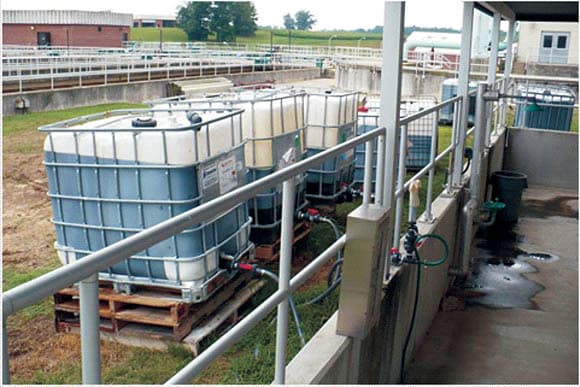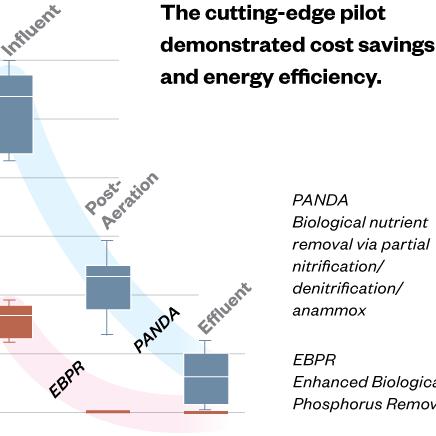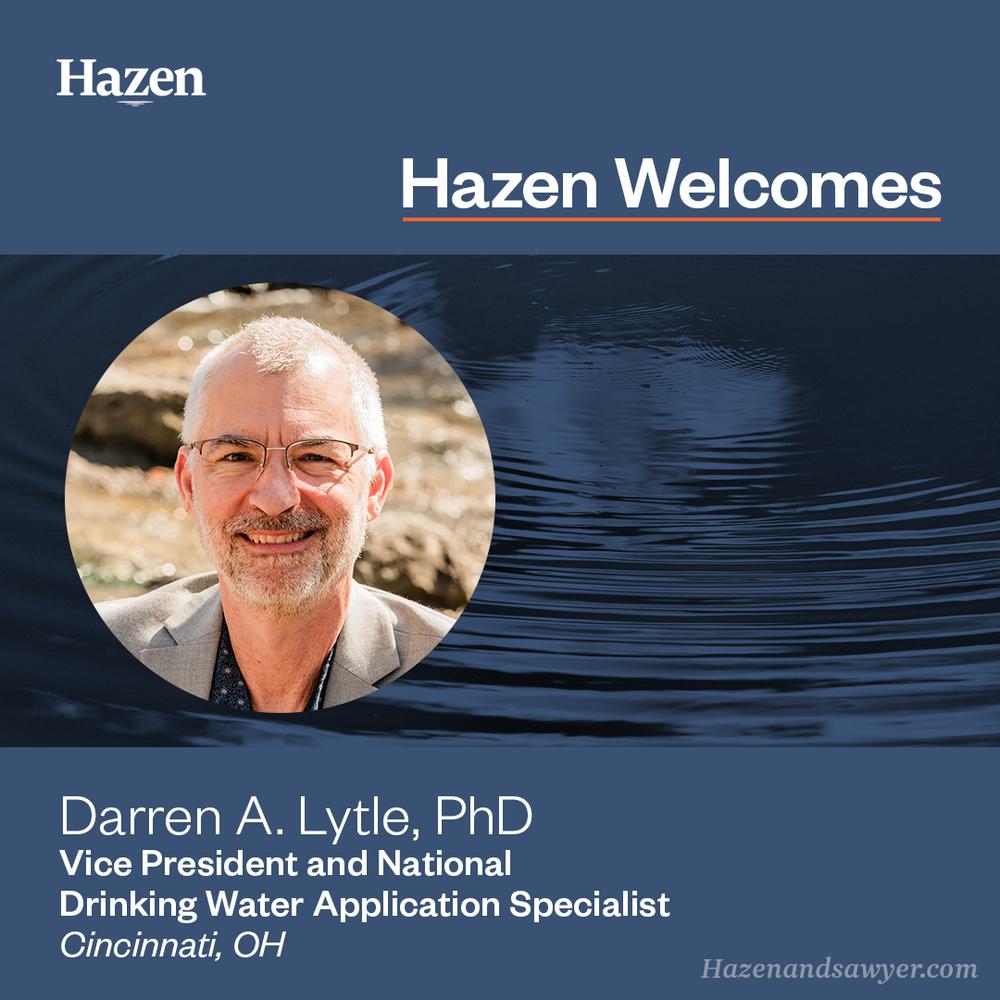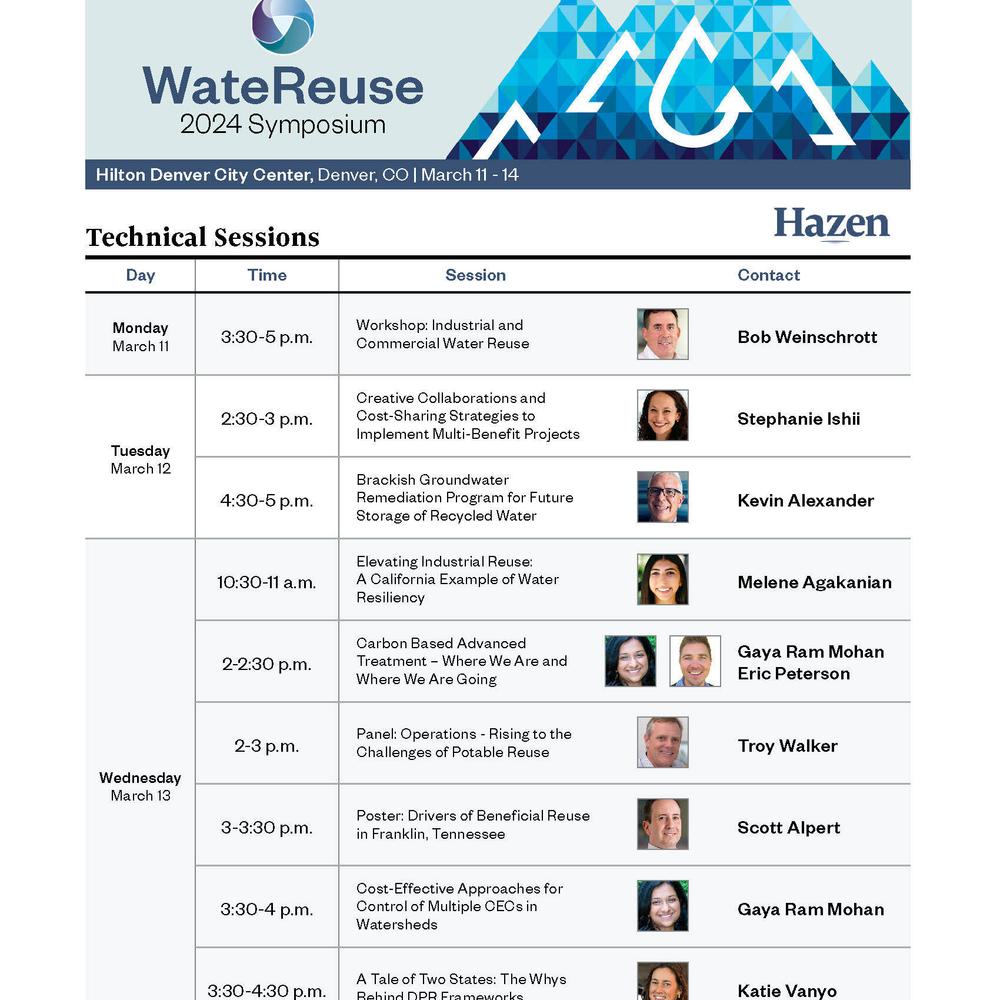Finding Flexibility in Carbon Supplementation
Last Modified Aug 01, 2022

An increasing number of wastewater treatment facilities are faced with the challenge of removing total nitrogen (TN) from their effluent to comply with concentration-based or annual mass limits on plant discharges to waterbodies. Supplemental carbon is often added to the post-anoxic zone and/or denitrification filters to reduce nitrate to meet these effluent TN objectives. Hazen and Sawyer has conducted pilot test programs to evaluate the efficacy of many alternative carbon sources, and performed field investigations and bench scale experiments as part of these pilots. Our findings can inform flexible facility design that accommodates a number of different supplemental carbon sources, offering Owners the opportunity to use market conditions to make cost-saving decisions.
Nitrogen removal facilities often employ enhanced biological nutrient removal (ENR) processes, such as the 5-stage process shown in the figure above, and/or denitrification filters to remove residual nitrate from the secondary process. Denitrification requires a readily biodegradable carbon source, which is often limited in or exhausted prior to the post-anoxic zones or denitrification filter.
Methanol has historically been used for denitrification; however, recent cost volatility and safety concerns associated with methanol have led utilities to consider potentially safer, more sustainable carbon sources. Several carbon sources viewed as promising, more-sustainable replacements for methanol include glycerin-based products derived from biodiesel production, as well as several sugar-based waste products from the food and beverage industry. Glycerin products are available in both a refined, proprietary form and in a crude, potentially more variable form. Hazen and Sawyer has assisted many clients in full-scale testing of these alternative carbon products; findings from four of the most interesting pilots follow.
Related Topics:

Neuse River Wastewater Treatment Plant (NRWWTP)
75 mgd, Raleigh, NC (glycerin)
The NRWWTP has an effluent TN limit of 2.5 mg/L and is currently the largest wastewater treatment facility meeting “Limits of Technology” TN limits on the East Coast. The plant has historically used methanol in its post-anoxic zone and denitrification filters, and was seeking a safer, cost-effective product. Many plants including the NRWWTP combine 5-stage BNR with denitrification filter technology and are looking for a single carbon source to satisfy both processes economically.
A 75% crude glycerin product was piloted in one of six bioreactors in June and July of 2008. Methanol continued to be fed to the remaining bioreactors, and one of these basins was used as a control to compare performance with the glycerin-fed bioreactor. The results of the full-scale test demonstrated that the mass of nitrate denitrified with the glycerin product was comparable to the mass of nitrate removed with methanol at an equivalent feed rate (1 gallon methanol = 1 gallon of glycerin). However, the properties of glycerin vary by manufacturer, so the required feed rate of glycerin may be higher or lower than methanol. The full-scale testing also indicated that there was no acclimation period required for the biomass to fully utilize the glycerin product.
The glycerin product was also applied to the denitrification filters. Little if any denitrification occurred on the filters, which may be attributed to high dissolved oxygen (DO) concentrations in the filter influent. In addition, the filter run times between backwashes typically decreased as the glycerin feed rate increased. It is hypothesized that nearly all of the glycerin applied to the filters is being used aerobically, and the increased frequency of backwashes may be due to growth of aerobic bacteria. More research is needed to understand the effectiveness and operational impacts of glycerin and other alternative carbon source addition to denitrification filters.
More on our work at the Neuse River WWTP

Henrico County Water Reclamation Facility (HCWRF)
75 mgd, Petersburg, VA (corn syrup, glycerin)
The HCWRF has a current TN limit of 8 mg/L and a future TN limit of 5 mg/L. Hazen and Sawyer and the plant staff have worked together to identify a variety of optimization strategies that have improved the effectiveness and efficiency of nitrogen removal. One of those efforts involved using a safe and sustainable carbon source. For more than two years, Hazen and Sawyer assisted HCWRF in performing a full-scale pilot using corn syrup waste, and, more recently, we have piloted different glycerin products with success. During these full-scale pilots, Hazen and Sawyer optimized the product usage through detailed nutrient profiles that are a routine part of the pilot program but not often part of day-to-day operational data collection. This optimization and change in carbon source has resulted in a chemical savings of $400,000 per year. In addition to carbon source optimization, the blowers and DO in the zone upstream of the carbon addition point were optimized, resulting in a 20% electrical savings, or $300,000 per year, in power costs.
More on our work at the Henrico County WRF

Parkway Wastewater Treatment Plant (PWWTP)
7.5 mgd, Laurel, MD (glycerin)
The Washington Suburban Sanitation Commission (WSSC) has performed full-scale testing of several alternative carbon sources at the PWWTP in an effort to meet a future TN limit of 3 mg/L. Hazen and Sawyer assisted the WSSC during pilot testing of three glycerin products by providing bench-scale testing and full-scale process profiling services. The results were utilized in Hazen and Sawyer’s design of nutrient removal facilities including flexible carbon feed systems at the PWWTP.
Unicarb-DN was piloted in October 2007, and Brenntag and Virginia Biodiesel glycerin products were piloted in December 2007 and February 2008, respectively. The three products performed similarly and the full-scale pilot confirmed glycerin products were effective carbon sources for post-anoxic zone denitrification, although cold weather storage and pumping issues related to product viscosity need to be addressed. No acclimation period was required, as robust denitrification was observed within one day of adding these products.
Hazen and Sawyer performed bench scale testing on the Brenntag and Virginia Biodiesel products. The carbon feed ratios derived from the bench-scale tests were approximately 30% lower than the ratios observed in the field per equivalent amount of nitrate removed. This may be due to field conditions including substrate limitations, do impacts, and back-mixing. This underscores that care should be exercised when applying the results of denitrification batch testing to full-scale facilities or to other plants, as there is a risk of undersizing denitrification tankage and carbon feed facilities if bench-scale rates are applied to a full-scale process without adjustment for field conditions.

South Durham Water Reclamation Facility (SDWRF)
20 mgd, Durham, NC (glycerin)
The City of Durham, North Carolina, piloted several glycerin products to determine whether glycerin addition could assist the City in meeting an upcoming TN effluent standard of 3.0 mg/L. Hazen and Sawyer assisted the City in piloting the Brenntag glycerin product at the SDWRF from March 2009 through May 2009. Glycerin was added to the post-anoxic zone of the test basin, and nutrient profiles were performed in the test and control basins.
The results from the first six weeks of pilot testing did not directly indicate any decrease in effluent nitrate concentrations between the test and control basins. This was attributed to reduced nitrification performance in, and high residual DO entering, the post anoxic zone of the test basin, underscoring the importance of monitoring DO and ammonia in addition to nitrate and nitrite in and out of the post-anoxic zone in assessing denitrification performance. DO management is extremely important in wastewater treatment plants to avoid wasting supplemental carbon as well as aeration energy, both of which are significant operational expenditures at wastewater treatment facilities.
The feed rate was increased beginning the week of April 21st to overcome residual oxygen demand in the anoxic zone, and the test basin removed 1 to 2 mg/L more nitrate than the control once the feed rate was increased. Subsequent testing indicated that denitrification was successfully enhanced through glycerin addition. Construction of permanent supplemental carbon storage and feed facilities will allow the City to avoid more costly capital improvements.
More on our work at the South Durham WRF
Carbon Evaluation Methodology
Hazen and Sawyer has developed a methodology to evaluate the cost of various carbon sources on a cost-per-pound-of-nitrate-removed basis. This price comparison considers all applicable variables including solution strength, density, soluble biodegradable COD content, cost per gallon and anoxic yield. Costs were derived from current market pricing for the mid-Atlantic facilities discussed, and will have some variability from plant to plant. The cost analysis indicates that, in this region, glycerin products are currently most cost-competitive with methanol, while acetic acid and corn syrup tend to be more expensive.
Planning for Design
Providing flexible supplemental carbon facility design requires ensuring that materials of construction, pumps, piping, and appurtenant equipment are compatible with a variety of carbon sources. For example, 304 stainless steel storage tanks and piping are compatible with most supplemental carbon products except for acetic acid, where 316 stainless steel is recommended. Materials can be selected that reduce the cost and flexibility of the facility. Fiber-reinforced plastic and crosslinked polyethylene tanks are compatible with glycerin products, but would not be suitable for methanol and ethanol. Design of carbon storage and feed facilities must take into account the client’s preferences for flexibility versus increased cost and complexity.
Using our own sampling teams and equipment, Hazen and Sawyer can evaluate and diagnose process performance within a one-day test period. For Owners facing economic pressures and tough nitrogen limits, knowing and understanding all the available treatment options can save capital costs now and operating costs long into the future.











